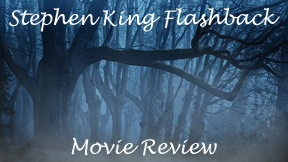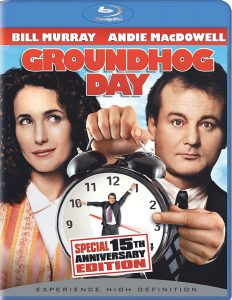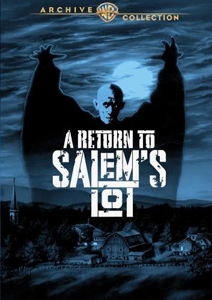“A Return to Salem’s Lot” (1987) – the movie sequel to the 1979 TV miniseries – represents the perils of selling cinematic rights to your books. Director/co-writer Larry Cohen’s film uses the title and logo of Stephen King’s book, and the artwork uses the vampire from the first film, and this is ostensibly based on “characters created by Stephen King.”
Retrofitted to Salem’s Lot
But those are all for the sake of selling the product. “Return” is an original Cohen story (written as a screenplay along with James Dixon) that was adjusted to become a “Salem’s Lot” sequel in order to get more viewers.
It’s hard to pick out the dumbest part of the movie, but certainly the laziest bit of continuity (or lack thereof) is that Salem’s Lot has been filled with vampires for 300 years. In the original, a vampire sneaks into a normal town in 1979.

“A Return to Salem’s Lot” (1987)
Director: Larry Cohen
Writers: Larry Cohen (screenplay, story), James Dixon (screenplay)
Stars: Michael Moriarty, Ricky Addison Reed, Samuel Fuller
As with the original – which I liked less than most people do, but which looks like “Citizen Kane” compared to this – the problem with “Return” is the execution more so than the ideas. Cohen comes up with a proto-“True Blood” in the style of an “X-Files” episode (if “The X-Files” was terrible instead of great).
This community of vampires lives peacefully, subsisting on cow’s blood – and it doesn’t even kill the cows. As one of the vampires notes, humans slaughter cows – so which species is more humane?
Not under their sway
Anthropologist Joe (Michael Moriarty) inherits his aunt’s house in Salem’s Lot, and he visits with teen son Jeremy (Ricky Addison Reed). Joe is technically a deadbeat dad, but if there’s such a thing as a deadbeat son, Jeremy fits the bill. In the period where a better film would provide character development, “Return” establishes how whiny and annoying Jeremy is.
Moriarty gives a similarly measured performance to his “Law & Order” work, making him one of the most unfazed actors I’ve ever seen, because his own dialog and everything going on around him is atrocious.
Two other actors are able to dust off embarrassment, in that they are clearly better than the material. Samuel Fuller, giving a Peter Falk-esque turn, steps in as cigar-sucking Van Meer, who inexplicably knows all about vampires. And Andrew Duggan has appropriate weight as Axel, the vampire community leader.
But everyone else is awful. First takes seem to have been used for everything. Among the supporting cast is a young Tara Reid as a vampire who holds Jeremy under her sway. The future “American Pie” actress became a star, but if that had anything to do with her acting ability, that’s not evident here.

The way Joe, Jeremy and Van Meer team up to fight the vampires is shallowly King-esque – three strangers (yes, two of them are father and son, but they’ve essentially just met) find themselves as the de facto forces of light thrown into a battle against the forces of darkness.
Stiff direction (no pun intended)
But the stiff direction, editing and acting sucks the life out of everything. Hilariously bad stunt sequences are icing on the cake. “Return” was shot in Vermont, so that’s presumably better than the Burbank lot of the original miniseries. But it’s not enough to save it, even with “Texas Chain Saw Massacre’s” Daniel Pearl manning the camera.
In one action sequence, Joe fights drones (humans who serve the vampires) in a rocky riverbed, and I was scared for the performers. This is a shoddy enough project where I believed someone could truly hit their head on a rock doing a poorly planned stunt.
As for in-movie scares? There aren’t any, but a few shots of monster makeup are competent, including one where Joe stakes a vampire in its coffin and it suddenly turns monster-faced in its death throes. Even here, the editors cut away quickly as if the work won’t hold up to scrutiny for more than a second.
Unfortunately, that philosophy doesn’t extend to the overall film, which lasts 100 minutes. That’s not generally considered a lengthy cut, but “A Return to Salem’s Lot” runs on eternal undead time. One character shoots himself to escape. As a viewer, I don’t blame him.
On Fridays, RFMC reviews a Stephen King book, adaptation or related work. Click here to visit our Stephen King Zone.

